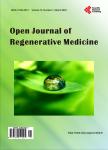Evaluation of <i>in vivo</i>migration of chondrocytes from tissue-engineered cartilage that was subcutaneously transplanted in mouse model
Evaluation of <i>in vivo</i>migration of chondrocytes from tissue-engineered cartilage that was subcutaneously transplanted in mouse model作者机构:Department of Cartilage & Bone Regeneration (Fujisoft) Graduate School of Medicine The University of Tokyo Tokyo Japan Department of Sensory and Motor System Medicine The University of Tokyo Hospital Tokyo Japan NAGATA Microtia and Reconstructive Plastic Surgery Clinic Toda Saitama Japan Translational Research Center The University of Tokyo Hospital Tokyo Japan
出 版 物:《Open Journal of Regenerative Medicine》 (再生医学期刊(英文))
年 卷 期:2013年第2卷第4期
页 面:93-98页
学科分类:1002[医学-临床医学] 100214[医学-肿瘤学] 10[医学]
主 题:Cartilage Tissue Engineering Chondrocyte Migration
摘 要:For regenerative medicine, clarification of in vivo migration of transplanted cells is an important task to secure the safety of transplanted tissue. We had prepared tissue-engineered cartilage consisting of cultured chondrocytes with collagen hydrogel and a biodegradable porous polymer, and we clinically applied it for treatment of craniofacial anomaly. To verify the safety of this tissue-engineered cartilage, we had syngenically transplanted the tissue-engineered cartilage using chondrocytes harvested from EGFP-transgenic mice into subcutaneous pocket of wild type mice, and investigated localizations of transplanted chondrocytes in various organs including cerebrum, lung, liver, spleen, kidney, auricle, gastrocnemius, and femur. After 8 to 24 weeks of the transplantation, accumulation of cartilaginous matrices was observed in tissue-engineered cartilage, while EGFP-positive transplanted chondrocytes were localized in this area. Otherwise, no EGFP was immunohistochemically detected in each organ, suggesting that subcutaneously-transplanted chondrocytes do not migrate to other organs through the circulation. In cartilage tissue engineering using cultured chondrocytes, risk for migration and circulation of transplanted cells seemed negligible, and that ectopic growth of the cells was unlikely to occur, showing that this is safe technique with regard to the in vivo migration of transplanted cells.



